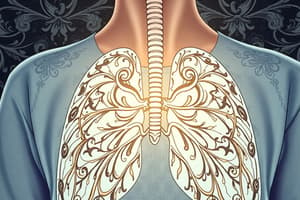Podcast
Questions and Answers
What is the correct nursing intervention for a patient with a chest tube?
What is the correct nursing intervention for a patient with a chest tube?
- Drainage containers are positioned upright or on the bed next to the patient
- The patient is encouraged to cough and do deep-breathing exercises frequently (correct)
- Water level in the suction chamber need not be monitored, just the collection chamber
- "Stripping" of the chest tubes is done routinely to prevent obstruction by blood clots
How has the nurse identified a leak in the chest tube system?
How has the nurse identified a leak in the chest tube system?
- Fluctuation in the water seal chamber has stopped
- The bubbling in the suction chamber has suddenly increased
- Drainage in the collection chamber has decreased
- There was onset of continuous vigorous bubbling in the water seal chamber (correct)
To implement an increase in the suction to -20 cm for a patient with a chest tube, which intervention should the nurse perform?
To implement an increase in the suction to -20 cm for a patient with a chest tube, which intervention should the nurse perform?
- Stops the suction, adds sterile water to the level of -20 cm in the water seal chamber and resumes the wall suction (correct)
- Increases the wall suction to the medium setting and observes gentle bubbling in the suction chamber
- Has the patient cough and deep-breathe and monitors the level of fluctuation to achieve -20 cm
- Adds water to the suction and drainage chambers to the level of -20 cm
What does the water in the water seal chamber do when the system is functioning correctly?
What does the water in the water seal chamber do when the system is functioning correctly?
What is the nurse's best action for a patient with a chest tube whose drainage was 110 mL over the past hour?
What is the nurse's best action for a patient with a chest tube whose drainage was 110 mL over the past hour?
What does the nurse expect the tube in the second intercostal space to accomplish?
What does the nurse expect the tube in the second intercostal space to accomplish?
How should the nurse monitor for the complication of subcutaneous emphysema after the insertion of chest tubes?
How should the nurse monitor for the complication of subcutaneous emphysema after the insertion of chest tubes?
What initial action should the nurse take if the water in the underwater seal tube is not fluctuating?
What initial action should the nurse take if the water in the underwater seal tube is not fluctuating?
What likely cause of the spontaneous pneumothorax should the nurse's response take into consideration?
What likely cause of the spontaneous pneumothorax should the nurse's response take into consideration?
Flashcards are hidden until you start studying
Study Notes
Chest Tubes Nursing Interventions
- Encourage frequent coughing and deep-breathing exercises to promote lung expansion.
- "Stripping" of chest tubes is not a routine practice; it could lead to complications.
- Monitor both the suction chamber and collection chamber water levels to ensure proper function.
- Position drainage containers upright to prevent kinks in the system.
Identifying Chest Tube Leaks
- Presence of continuous vigorous bubbling in the water seal chamber indicates a leak.
- A decrease in drainage is not a reliable indicator of a leak.
- Increased bubbling in the suction chamber does not confirm a leak.
- Stopping fluctuation in the water seal chamber may signal issues elsewhere.
Adjusting Suction Pressure
- Increase wall suction to achieve -20 cm by adding sterile water to the water seal chamber.
- Gentle bubbling in the suction chamber is a sign of correct suction settings.
- Do not add water to prevent overfilling suction and drainage chambers unnecessarily.
- Avoid stopping suction when making adjustments to maintain lung pressure.
Normal Function of Water Seal Chamber
- Proper function is marked by fluctuation in the water seal chamber corresponding to the patient’s breathing.
- Continuous or vigorous bubbling suggests issues ranging from air leaks to pressure problems.
- Lack of fluctuation signals a potential malfunction or untreated lung reexpansion.
Drainage Concerns
- Significant drainage of 110 mL in an hour may warrant immediate notification to the surgeon.
- Assess the chest tube system for leaks if excessive drainage is observed.
- Gentle "milking" of the tubing should be performed with caution and only if clots are suspected.
Chest Tube Insertion for Trauma
- A tube inserted in the second intercostal space is used to remove air from the intrapleural space.
- Tubes at the base of the lung primarily function to drain fluid.
- Emergency management focuses on restoring negative pressure in the pleural cavity.
Monitoring Subcutaneous Emphysema
- Palpate around insertion sites for crepitus, indicating air has escaped into soft tissue.
- Auscultation may reveal crackles, but tactile signs are more immediate indicators.
- Observe for abnormal chest shape changes as they may indicate complications.
Managing Chest Tube Function
- If the water seal tube does not fluctuate, first check for kinks or obstruction in the tubing.
- Patient positioning may help restore normal flow; repositioning can relieve pressure on the tubing.
- Regular assessment of vital signs is also important but not the first action in assessing functionality.
Causes of Spontaneous Pneumothorax
- Spontaneous pneumothorax is often linked to the rupture of subpleural blebs, which are air-filled blisters on the lung's surface.
- Pay attention to other potential related conditions, but bleb rupture is the most common cause.
- Knowledge of these ruptures is crucial for patient education concerning risk factors and prevention strategies.
Studying That Suits You
Use AI to generate personalized quizzes and flashcards to suit your learning preferences.





